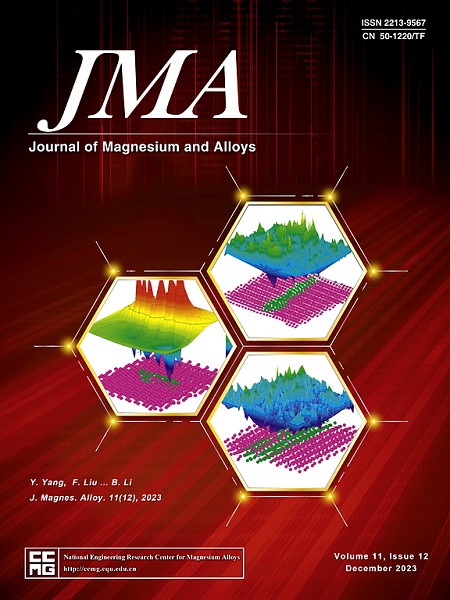通过平衡晶粒细化和动态析出弱化,提高镁镉银合金的时效硬化能力和强度
IF 15.8
1区 材料科学
Q1 METALLURGY & METALLURGICAL ENGINEERING
引用次数: 0
摘要
在追求高强度时效硬化镁合金时,通常面临着在优异的晶界强化和优异的析出强化之间进行选择的难题。本文提出了一种平衡晶粒细化和弱化动态析出的策略,并将其应用于Mg-10.95Gd-2.06Ag (wt%)合金,该合金经过等道角压(ECAP)、热轧和时效的顺序处理。热轧导致在先前的ECAP过程中密集形成的动态析出物的明显溶解,以及可容忍的晶粒长大。同时,以共轴晶界(cgb)为界的多孪晶片层带(LBs)将晶粒进一步细分。首次提出了四重孪晶模式,用于形成取向偏差为~ 135°的CGB。在轧制后时效过程中,除常见的β′和γ′相以及Gd/Ag比远低于动态析出的β纳米颗粒外,lb内的β′/β t相、CGB偏析和层错(SF)相关的偏析/γ′相也与析出结构有关。得益于这种复杂的析出组织,合金具有良好的时效硬化能力,其时效诱导抗拉屈服强度(TYS)增量可达115 MPa。结合晶界、位错、溶质和基底织构的强化,获得了447兆帕的高TYS。本文章由计算机程序翻译,如有差异,请以英文原文为准。

Towards age-hardening ability enhancement and high strength in Mg–Gd–Ag alloy by balancing grain refinement and weakening of dynamic precipitation
The dilemma of choosing between superb grain boundary strengthening and excellent precipitation strengthening is commonly faced in the pursuit of high-strength age-hardenable Mg alloys. Here, a strategy for addressing this dilemma via the balance between grain refinement and weakening of dynamic precipitation is proposed and applied on a Mg–10.95Gd–2.06Ag (wt%) alloy treated by sequential processing of equal-channel angular pressing (ECAP), hot rolling and aging. The hot rolling leads to a noticeable dissolution of the dynamic precipitates intensively formed during prior ECAP, together with a tolerable grain growth. Meanwhile, numerous multi-twinning-induced lamellar bands (LBs) demarcated by coaxial grain boundaries (CGBs) subdivide the grains. For the first time, a quadruple twinning pattern for the formation of CGB with a misorientation of ∼135° is raised. During post-rolling aging, besides the common β’ and γ” precipitates and the β nano-particles whose Gd/Ag ratio is much lower than that of dynamically precipitated β particles, the β”/βT precipitates, CGB segregation, and stacking fault (SF)-associated segregation/γ’ precipitates within LBs, are also involved with the precipitation structure. Benefiting from this complex precipitation structure, a good age-hardening ability manifested by the aging-induced tensile yield strength (TYS) increment reaching 115 MPa is attained. Combining with the strengthening from grain boundaries, dislocations, solutes, and basal texture, a high TYS of 447 MPa is achieved.
求助全文
通过发布文献求助,成功后即可免费获取论文全文。
去求助
来源期刊

Journal of Magnesium and Alloys
Engineering-Mechanics of Materials
CiteScore
20.20
自引率
14.80%
发文量
52
审稿时长
59 days
期刊介绍:
The Journal of Magnesium and Alloys serves as a global platform for both theoretical and experimental studies in magnesium science and engineering. It welcomes submissions investigating various scientific and engineering factors impacting the metallurgy, processing, microstructure, properties, and applications of magnesium and alloys. The journal covers all aspects of magnesium and alloy research, including raw materials, alloy casting, extrusion and deformation, corrosion and surface treatment, joining and machining, simulation and modeling, microstructure evolution and mechanical properties, new alloy development, magnesium-based composites, bio-materials and energy materials, applications, and recycling.
 求助内容:
求助内容: 应助结果提醒方式:
应助结果提醒方式:


